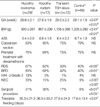1. Uhrmann S, Marks KH, Maisels MJ, Friedman Z, Murray F, Kulin HE, Kaplan M, Utiger R. Assessment of Thyroid function in the preterm infant: a longitudinal assessment. J Pediatr. 1978. 92:968–973.
2. Mandel SJ, Hermos RJ, Larson CA, Prigozhin AB, Rojas DA, Mitchell ML. Atypical hypothyroidism and the very low birthweight infant. Thyroid. 2000. 10:693–695.

3. van Wassenaer AG, Kok JH. Hypothyroxinaemia and thyroid function after preterm birth. Semin Neonatol. 2004. 9:3–11.

4. Perlman JM. Neurobehavioral deficits in premature graduates of intensive care-potential medical and neonatal environmental risk factors. Pediatrics. 2001. 108:1339–1348.

5. Gressens P, Rogido M, Paindaveine B, Sola A. The impact of neonatal intensive care practices on the developing brain. J Pediatr. 2002. 140:646–653.

6. Rapaport R. Thyroid function in the very low birth weight newborn: rescreen or reevaluate? J Pediatr. 2002. 140:287–289.

7. Vincent MA, Rodd C, Dussault JH, Van Vliet G. Very low birth weight newborns do not need repeat screening for congenital hypothyroidism. J Pediatr. 2002. 140:311–314.

8. Frank JE, Faix JE, Hermos RJ, Mullaney DM, Rojan DA, Mitchell ML, Klein RZ. Thyroid function in very low birthweight infants: effects on neonatal hypothyroidism screening. J Pediatr. 1996. 128:548–554.
9. Larson C, Hermos R, Delaney A, Daley D, Mitchell M. Risk factors associated with delayed thyrotropin elevations in congenital hypothyroidism. J Pediatr. 2003. 143:587–591.

10. Delange F, Dalhem A, Bourdoux P, Lagasse R, Glinoer D, Fisher DA, Walfish PG, Ermans AM. Increased risk of primary hypothyroidism in preterm infants. J Pediatr. 1984. 105:462–469.

11. Rooman RP, Du Caju MV, De Beeck LO, Docx M, Van Reempts P, Van Acker KJ. Low thyroxinaemia occurs in the majority of very preterm newborns. Eur J Pediatr. 1996. 155:211–215.

12. Delange F. Optimal iodine nutrition during pregnancy, lactation and the neonatal period. Int J Endocrinol Metab. 2004. 2:1–12.
13. Ares S, Escobar-Morreale HF, Quero J, Duran S, Presas MJ, Herruzo R, Morreale de Escobar G. Neonatal hypothyroxinemia: effects of iodine intake and premature birth. J Clin Endocrinol Metab. 1997. 82:1704–1712.
14. Ibrahim M, de Escobar GM, Visser TJ, Duran S, van Toor H, Strachan J, Williams FL, Hume R. Iodine deficiency associated with parenteral nutrition in extreme preterm infants. Arch Dis Child Fetal Neonatal Ed. 2003. 88:F56–F57.

15. van Wassenaer AG, Stulp MR, Valianpour F, Tamminga P, Ris Stalpers C, de Randamie JS, van Beusekom C, de Vijlder JJ. The quantity of thyroid hormone in human milk is too low to influence plasma thyroid hormone levels in the very preterm infant. Clin Endocrinol (Oxf). 2002. 56:621–627.

16. Moon S, Kim J. Iodine content of human milk and dietary iodine intake of Korean lactating mothers. Int J Food Sci Nutr. 1999. 50:165–171.
17. Smerdely P, Lim A, Boyages SC, Waite K, Wu D, Roberts V, Leslie G, Arnold J, John E, Eastman CJ. Topical iodine-containing antiseptics and neonatal hypothyroidism in very-low-birthweight infants. Lancet. 1989. 2:661–664.

18. Linder N, Davidovitch N, Reichman B, Kuint J, Lubin D, Meyerovitch J, Sela BA, Dolfin Z, Sack J. Topical iodine-containing antiseptics and subclinical hypothyroidism in preterm infants. J Pediatr. 1997. 131:434–439.

19. Brown R, Huang S. Brook C, Clayton P, Brown R, editors. Thyroid and its disorders. Brook's clinical endocrinology. 2005. 5th ed. Malden, Mass: Blackwell Publishing;218–253.
20. FAO/WHO. Vitamin and mineral requirements in human nutrition. 2005. 2nd ed. Geneva: WHO publication;303–317.
21. Rapaport R, Rose SR, Freemark M. Hypothyroxinemia in the preterm infant: the benefits and risks of thyroxine treatment. J Pediatr. 2001. 139:182–188.

22. Ogilvy-Stuart AL. Neonatal thyroid disorders. Arch Dis Child Fetal Neonatal Ed. 2002. 87:F165–F171.

23. van Wassenaer AG, Kok JH, de Vijlder JJ, Briet JM, Smit BJ, Tamminga P, van Baar A, Dekker FW, Vulsma T. Effects of thyroxine supplementation on neurologic development in infants born at less than 30 weeks' gestation. N Engl J Med. 1997. 336:21–26.

24. van Wassenaer AG, Briet JM, van Baar A, Smit BJ, Tamminga P, de Vijlder JJ, Kok JH. Free thyroxine levels during the first weeks of life and neurodevelopmental outcome until the age of 5 years in very preterm infants. Pediatrics. 2002. 110:534–539.

25. van Wassenaer AG, Westera J, Houtzager BA, Kok JH. Ten-year follow-up of children born at <30 weeks' gestational age supplemented with thyroxine in the neonatal period in a randomized, controlled trial. Pediatrics. 2005. 116:e613–e618.
26. Abbassi V, Adams J, Duvall D, Phillips E. Prenatal thyroid function abnormalities in infants with idiopathic respiratory distress syndrome. Pediatr Res. 1984. 18:926–928.







 PDF
PDF ePub
ePub Citation
Citation Print
Print



 XML Download
XML Download